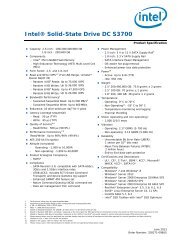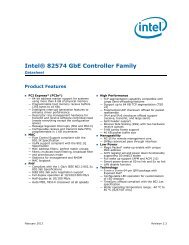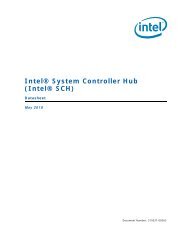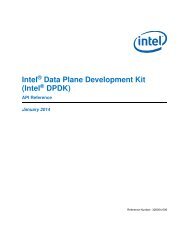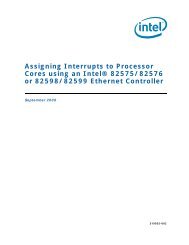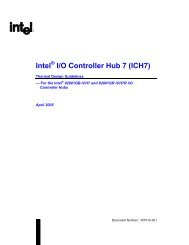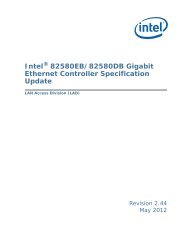Intel Itanium Processor 9300 Series and 9500 Series
Intel Itanium Processor 9300 Series and 9500 Series
Intel Itanium Processor 9300 Series and 9500 Series
Create successful ePaper yourself
Turn your PDF publications into a flip-book with our unique Google optimized e-Paper software.
Introduction<br />
Figure 1-1.<br />
<strong>Intel</strong> ® <strong>Itanium</strong> ® <strong>Processor</strong> <strong>9300</strong> <strong>Series</strong> <strong>Processor</strong> Block Diagram<br />
Core0<br />
Core1<br />
Core2<br />
Core3<br />
CPE0<br />
CPE1<br />
CPE2<br />
CPE3<br />
<strong>Intel</strong>® SMI<br />
<strong>Intel</strong>® SMI<br />
Pbox<br />
PZ0<br />
Zbox0 Bbox0<br />
8 7 3<br />
2<br />
Rbox<br />
0xA 0<br />
1 6 9 5<br />
4 0xB<br />
Bbox1 Zbox1<br />
Pbox<br />
PZ1<br />
<strong>Intel</strong>® SMI<br />
<strong>Intel</strong>® SMI<br />
Pbox<br />
PH4<br />
Pbox<br />
PR 0<br />
Pbox<br />
PR1<br />
Pbox<br />
PR 2<br />
Pbox<br />
PR 3<br />
Pbox<br />
PH5<br />
<strong>Intel</strong>®<br />
QPI<br />
<strong>Intel</strong>®<br />
QPI<br />
<strong>Intel</strong>®<br />
QPI<br />
<strong>Intel</strong>®<br />
QPI<br />
<strong>Intel</strong>®<br />
QPI<br />
<strong>Intel</strong>®<br />
QPI<br />
1.2.2 <strong>Intel</strong> ® <strong>Itanium</strong> ® <strong>Processor</strong> <strong>9500</strong> <strong>Series</strong> Overview<br />
The <strong>Intel</strong> ® <strong>Itanium</strong> ® <strong>Processor</strong> <strong>9500</strong> <strong>Series</strong> is an eight core architecture. It supports up<br />
to eight cores, each with its own First Level Cache (FLC) <strong>and</strong> Mid Level Cache (MLC),<br />
both of which are split into instruction <strong>and</strong> data caches (FLI/FLD <strong>and</strong> MLI/MLD,<br />
respectively). The Last Level Cache (LLC) is shared among the cores <strong>and</strong> supports up to<br />
32 MB. Also supported are the following page sizes for purges or inserts: 4K, 8K, 16K,<br />
64K, 256K, 1M, 4M, 16M, 64M, 256M, 1G, 4G.<br />
The architecture interfacing the cores to the system is referred to as the uncore. Each<br />
<strong>Intel</strong> ® <strong>Itanium</strong> ® <strong>Processor</strong> <strong>9500</strong> <strong>Series</strong> core interfaces to the Ring. The Ring provides<br />
connectivity to the Last Level Cache via the Cache Controllers (Cboxes). The Ring also<br />
provides connectivity to <strong>Intel</strong> QPI via Ring/Sbox. The Sbox <strong>and</strong> Cbox provide the<br />
supports for the two <strong>Intel</strong> QPI Caching Agents. The processor has two Home Agents<br />
(Bbox). The Bbox interfaces between the memory controller <strong>and</strong> the <strong>Intel</strong> ® QuickPath<br />
Interconnect <strong>and</strong> supports a directory cache. Each memory controller supports two<br />
<strong>Intel</strong> ® Scalable Memory Interconnects (<strong>Intel</strong> ® SMI) in lockstep. The <strong>Intel</strong> SMI are the<br />
interconnects to Scalable Memory Buffer. The <strong>Intel</strong> ® <strong>Itanium</strong> ® <strong>Processor</strong> <strong>9500</strong> <strong>Series</strong><br />
processor supports six <strong>Intel</strong> ® QuickPath Interconnects at the socket, four full width <strong>and</strong><br />
two half width. The Caching Agent, Home Agent, <strong>and</strong> <strong>Intel</strong> ® QuickPath Interconnects<br />
are connected via a 10-port Crossbar Router, each port supporting the <strong>Intel</strong> ® QuickPath<br />
Interconnect protocol. Figure 1-2 shows the processor block diagram.<br />
16 <strong>Intel</strong> ® <strong>Itanium</strong> ® <strong>Processor</strong> <strong>9300</strong> <strong>Series</strong> <strong>and</strong> <strong>9500</strong> <strong>Series</strong> Datasheet



